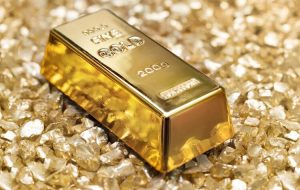Gold refreshes two-week high ahead of US inflation data
Share: Gold price holds gains tightly as Fed policymakers support an unchanged monetary policy ahead. The US Dollar reported bearish closes six times in a row as hawkish Fed bets wane. Investors await the US inflation data, which is expected to fall further. Gold price (XAU/USD) clings to gains backed by a

- Gold price holds gains tightly as Fed policymakers support an unchanged monetary policy ahead.
- The US Dollar reported bearish closes six times in a row as hawkish Fed bets wane.
- Investors await the US inflation data, which is expected to fall further.
Gold price (XAU/USD) clings to gains backed by a correction in the US Dollar and Treasury yields, which are due to falling expectations of one more interest rate increase from the Federal Reserve (Fed). The precious metal remains upbeat ahead of the Consumer Price Index (CPI) data for September, which will be published at 12:30 GMT.
While the majority of Fed policymakers favored an additional interest rate hike ahead as per FOMC minutes, rising long-term Treasury yields have forced them to support keeping interest rates steady. Higher bond yields are expected to slow down the pace of spending and investment. At this point of time, when inflation is consistently falling and Middle East tensions are deepening, risks of under-tightening would be lower than the consequences of tightening too much.
Daily Digest Market Movers: Gold price remains strong as US yields decline from peak
- Gold price extends recovery close to $1,880 as investors are expecting that the Federal Reserve will not raise interest rates further in the remainder of 2023.
- Rising expectations for the Fed keeping interest rates unchanged at 5.25-5.50% are backed by multi-year highs in long-term US Treasury yields, which are sufficient to squeeze spending and investment ahead.
- The 10-year US Treasury yield corrects from recent highs of 4.7% as the deepening Israel-Hamas conflict has also contributed to the decline in expectations of further policy-tightening.
- While investors see the Fed keeping interest rates steady ahead, policymakers have a different approach to the interest rate outlook.
- Atlanta Fed Bank President Raphael Bostic said on Tuesday that current monetary policy is sufficiently restrictive and inflation will come down to 2% without triggering a recession.
- Fed policymakers: San Francisco Fed Bank President Mary Daly and Dallas Fed Bank President Lorie Logan warned that higher long-term US Treasury yields could substitute the need of further interest rate hikes by making borrowing expensive. Fed’s Daly said that risk of under-tightening would be lower than the risk of raising rates too much.
- Fed Governor Michelle Bowman reiterated on Wednesday that further rate hikes are highly required to restore price stability despite some progress in inflation softening.
- Fed’s Bowman further added that after raising interest rates they should be kept higher for a longer period due to persistent risks of inflation amid robust consumer spending and upbeat labor market conditions.
- The US Dollar Index (DXY) extends its correction to near 105.50 despite a hot producer inflation report, released on Wednesday.
- The US Bureau of Labor Statistics reported that the September monthly headline Producer Price Index (PPI) rose at a higher pace of 0.5% vs. expectations of 0.4% and that core PPI grew by 0.3% against the estimates of 0.2%. On an annualized basis, the prices of core goods and services at factory gates jumped to 2.7%, above the 2.3% consensus.
- A surprisingly hot PPI report has improved the inflation outlook. For more clarity, investors will focus on the Consumer Price Index (CPI) data for September, which will be published at 12:30 GMT.
- As per the estimates, the monthly headline and core inflation are expected to register growth of 0.3%. Rising energy prices due to rallying global oil prices amid tight supply may result in sustained growth ahead. The impact of the rise in headline inflation would be limited to the interest rate plot.
- Annual headline and core inflation are seen declining to 3.6% and 4.1%, respectively. A surprisingly hot inflation report could set a hawkish undertone for the Fed’s monetary policy in November.
- The Federal Open Market Committee (FOMC) minutes for September released on Wednesday conveyed that a majority of policymakers at that meeting were in favor of one additional interest rate hike and keeping them restrictive for a longer period.
Technical Analysis: Gold price climbs close to $1,880
Gold price jumps to near $1,880.00 on Thursday as hawkish Fed bets swiftly fade away. The precious metal registers a fresh two-week high and is gathering strength for further upside. The yellow metal climbs above the 20-day Exponential Moving Average (EMA) around $1,872.00, which indicates that the short-term trend has turned bullish. The broader Gold price outlook is bearish as the 50 and 200-day EMAs have already delivered a Death Cross.
Inflation FAQs
Inflation measures the rise in the price of a representative basket of goods and services. Headline inflation is usually expressed as a percentage change on a month-on-month (MoM) and year-on-year (YoY) basis. Core inflation excludes more volatile elements such as food and fuel which can fluctuate because of geopolitical and seasonal factors. Core inflation is the figure economists focus on and is the level targeted by central banks, which are mandated to keep inflation at a manageable level, usually around 2%.
The Consumer Price Index (CPI) measures the change in prices of a basket of goods and services over a period of time. It is usually expressed as a percentage change on a month-on-month (MoM) and year-on-year (YoY) basis. Core CPI is the figure targeted by central banks as it excludes volatile food and fuel inputs. When Core CPI rises above 2% it usually results in higher interest rates and vice versa when it falls below 2%. Since higher interest rates are positive for a currency, higher inflation usually results in a stronger currency. The opposite is true when inflation falls.
Although it may seem counter-intuitive, high inflation in a country pushes up the value of its currency and vice versa for lower inflation. This is because the central bank will normally raise interest rates to combat the higher inflation, which attract more global capital inflows from investors looking for a lucrative place to park their money.
Formerly, Gold was the asset investors turned to in times of high inflation because it preserved its value, and whilst investors will often still buy Gold for its safe-haven properties in times of extreme market turmoil, this is not the case most of the time. This is because when inflation is high, central banks will put up interest rates to combat it.
Higher interest rates are negative for Gold because they increase the opportunity-cost of holding Gold vis-a-vis an interest-bearing asset or placing the money in a cash deposit account. On the flipside, lower inflation tends to be positive for Gold as it brings interest rates down, making the bright metal a more viable investment alternative.
| آموزش مجازی مدیریت عالی حرفه ای کسب و کار Post DBA + مدرک معتبر قابل ترجمه رسمی با مهر دادگستری و وزارت امور خارجه |  آموزش مجازی مدیریت عالی و حرفه ای کسب و کار DBA آموزش مجازی مدیریت عالی و حرفه ای کسب و کار DBA+ مدرک معتبر قابل ترجمه رسمی با مهر دادگستری و وزارت امور خارجه |  آموزش مجازی مدیریت کسب و کار MBA آموزش مجازی مدیریت کسب و کار MBA+ مدرک معتبر قابل ترجمه رسمی با مهر دادگستری و وزارت امور خارجه |
 مدیریت حرفه ای کافی شاپ |  حقوقدان خبره |  سرآشپز حرفه ای |
 آموزش مجازی تعمیرات موبایل آموزش مجازی تعمیرات موبایل |  آموزش مجازی ICDL مهارت های رایانه کار درجه یک و دو |  آموزش مجازی کارشناس معاملات املاک_ مشاور املاک آموزش مجازی کارشناس معاملات املاک_ مشاور املاک |
- نظرات ارسال شده توسط شما، پس از تایید توسط مدیران سایت منتشر خواهد شد.
- نظراتی که حاوی تهمت یا افترا باشد منتشر نخواهد شد.
- نظراتی که به غیر از زبان فارسی یا غیر مرتبط با خبر باشد منتشر نخواهد شد.





ارسال نظر شما
مجموع نظرات : 0 در انتظار بررسی : 0 انتشار یافته : ۰